- Getting around Lijiang. Dont stay in the Old Towns more than 2 days, there is nothing to do. KRISS Oct 9, 2013 05:46
- 2013 Beijing Temple Fair BENNYLAU Feb 26, 2013 03:29
- Malaysian traveling from KUL - LAX vis Shanghai PVG ZATI_DY Jan 3, 2013 20:15
Changing Fortunes of Zhongshan
- Views: 6376
- |Vote: 0 0
- |Add to Favorites
- |Recommend to Friends
The fact that we had missed the last turn was not surprising and proved to be an advantage. With no obvious road signs since we turned off five kilometers back it was not hard to miss – just a simple fork in the road, with one staying high and the other dropping into the valley floor. From the high road we now had a slightly obstructed bird’s eye view of the 800 year old stone bridge spanning the small boulder filled river below. The new village, all soul less red brick and concrete boxes side by side straddling the high road is not a pretty sight. I peek into the valley but there is still no sign of the old village, only bamboo and bananas growing on the slopes above some small ploughed fields.
We park the car across the river and up the slope where several buses and private cars have already half filled the area and hurry back down looking for a suitable washroom but it is hard to rush. Zhongshan Gu Zhen is picturesque and photogenic. With houses of timber, bamboo and white washed stucco perched above the river it looks much the same as it has for over one hundred years. I have my camera out and snap off a few shots as we wait for our driver to join us. The man is also an avid photographer with some good equipment and when he arrives he’s also in no hurry.
Opposite the village beside a small alter where incense is burning, steps cut into rocks lead down to the waters edge. Large platforms of rocks on either side preside over the narrow channel with a short concrete plank bridge across it. The water is clean and cool. Upstream from the crossing a few fishermen stand on rocks in ankle deep water and try their luck with long fishing poles. The ancient single span arched bridge looks modern but it was built with no mortar, crafted entirely of snuggly fitting stones.
The village is small – stretching just one kilometer along the riverbank, which has been strengthened with a stone retaining wall. There is just one walking street a few meters wide flagged with huge stones. Houses line both sides of this narrow street and in some places the roofs have been extended to completely cover the street, shielding it from the heat of the sun and the heavy summer rains. Most of the houses are built on three or four levels using solid timber poles for wall, floor and roof trusses. A whitewashed patchwork of woven bamboo panels coated in mud form the walls while the typical dark gray curved tiles grace their roofs. Small balconies overlooking the river and draped in blue and white batik print curtains complete the picture.
A century ago many of the properties on the topside of the street were owned by just one of the wealthy landowners in the district but that all changed during the Cultural Revolution. Today many of the locals are enjoying a new wealth as they accommodate a steady stream of tourists. One enterprising local has built a neat and tidy public washroom at the top end of the village where he sits all day collecting a small fee for each deposit made. With up to five hundred visitors passing through most days he makes a very tidy sum on his investment.
Zhongshan still has that ‘lived in’ look and feel about it. The carpenter still turns out short-legged wooden stools, rice steamers and farm tools leaving a tidy pile of wood shavings on the floor of his workshop. Next door the barber shaves a constant supply of scalps oblivious to the heavy stream of pedestrian traffic flowing by with cameras flashing. An older women stands beside her threshold fanning coals in a large standing wok preparing her barbeque for grilling tofu. The lady next door is selling glutinous rice cakes to which she adds a sweet filling before serving to her customers. One of the village’s specialties is a rice wine fermented with another grain, stored in glazed clay pots with red cloth covered lids.
Seafood, not from the ocean but from rivers, rice paddies and ponds jump, splash and wiggle while they wait for dinner. Fresh vegetables, bamboo shoots and wild grown bracken fern tips are amongst the many culinary delights certain to entice any hungry city slicker. Another practical woven item is the vegetable baskets designed to hang on the walls ensuring good circulation during storage and proving to be very functional storage and display containers in the bustling eateries along the street.
Bamboo, that wonderfully versatile grass grows all around Chongqing and is cut, stripped and woven into a multitude of useful everyday items like baskets, hats and chopsticks. I’m impressed with what I see made and still used in the village as well as being sold to tourists like me. A bright green delicately woven bamboo container impresses me enough to buy a couple for just two yuan each. I can’t help wondering how long they have taken to make. Filled with the mouth numbing Sichuan pepper and hung in your closet these should deter the bugs from eating your winter woolens.
My only other purchase for an equally realistic price is two pairs of very pretty woven grass sandals sometimes still worn by the men in these rural villages. Each shoe takes one day to weave. They truly are a work of art – the weaving and shaping alone is fascinating and with a combination of natural and pastel colours will make great wall art for my home. Although I’m not planning to wear them they are cool, light and very comfortable.
Beside a set of steps on a slight bend in the old flagged street an old woman works on a large circular funeral wreath weaving long lengths of cane into hoops. The even older buildings with their seasoned timbers rising above the worn flagstones of the streets hold everyone’s attention. Open doors invite a glance into cool, dark, simply furnished interiors. Antiques – hand carved wooden furniture, porcelain, paintings, jewelry and bric-a-brac are plentiful. Restaurants over looking the river, teahouses with bamboo deck chairs and mahjong tables and a growing number of small guesthouses invite a traveler to rest. These simply renovated homes - some with private bathrooms - offer guests an authentic village experience. We retrace out steps looking for somewhere cool and pleasant to have our lunch.
Getting drenched by torrential rain, common in this part of the country has been ingeniously overcome by the creation of the conical broad brimmed woven bamboo hat and a coat woven of palm fibers, which drapes over the shoulders and down the back. I quickly donned a hat to pose beside the raincoat urging my companions to quikly take a photo for me but we weren’t quick enough. One of the down sides of traveling is the overt curiosity of other tourists and those nearby did not miss this opportunity to ‘bag a foreigner’ with the lens. While it’s cute at first it quite often becomes irritating, as some of these camera happy tourists almost demand you join them in their holiday snaps. A few minutes earlier while I was buying my grass sandals I had disappointed one rather excited woman. Finding herself in such close proximity she literally foisted her camera in my face desperate for that rare shot. I suggested that she ask me first and when she did I politely refused but I’ve no doubt she got her photo.
Moments later my friend, who was taking a rest while we caught up to her, was man handled by a middle-aged women into a pose with her. She then nonchalantly dragged me in for another one. It was hard to refuse without making a small scene which would undoubtedly attract more unwanted attention and as my friend commented we will never be celebrities in our own countries so why not enjoy a little of it here. I’m sure this woman’s husband was not the only one pressing a shutter. Later, the sight of my friend sleeping in a bamboo deckchair while the rest of us eat lunch is too much for many other tourists. Although the street is quieter we’re still a curiosity and it would seem, a bonus catch for everyone who passes by. I watch, not amused as many try unsuccessfully to be discreet in their quest for a photo they would otherwise rarely get the chance to take.
It’s a lovely hot day despite not yet being summer and we choose to dine outdoors overlooking the river. Zhongshan has been a port for centuries with local farmers moving produce up river on their small boats for distribution around the district. We order a variety of dishes from the array of fresh vegetables and seafood on the floor of the kitchen across the street. There’s little breeze to stir the air as we relax and wait for our meal to be prepared. After lunch we all take to the deck chairs, which prove to be extremely comfortable. It’s tempting to buy one for my balcony and it’s hard to move on but we must return home tonight.
In the hills surrounding the village are remnants of a fortified wall. Change is coming to this little river port but for now the village makes an ideal weekend getaway offering hiking in the hills, a real rural experience and a relaxed and friendly atmosphere steeped in a history that may soon be lost in that ominous tide of changing fortunes that is surely sweeping in.
The Old Village of Zhongshan is one of ten similar villages in Jiang Jin County. JiangJin town is on the Yangtze River approximately one hour south of Chongqing. Zhongshan is an hour beyond this by private vehicle so allow longer on the bus.
The bus can be flagged down at the round about on the southern approach to the bridge across the Yangtze on the outskirts Jiangjin Town. There is a bus directly to Zhongshan or any bus passing by will do as the village is a short five kilometers off the road.
Simianshan Nature Reserve (Four Face Mountain) is also 80kms south of Jiangjin making a good weekend getaway in combination with Zhongshan.



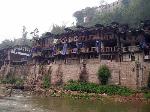
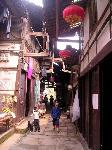
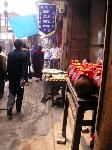
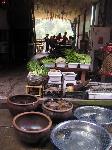
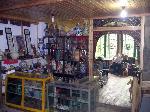

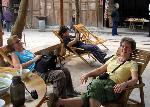
 Copyright © 1998-2025 All rights reserved.
Copyright © 1998-2025 All rights reserved.